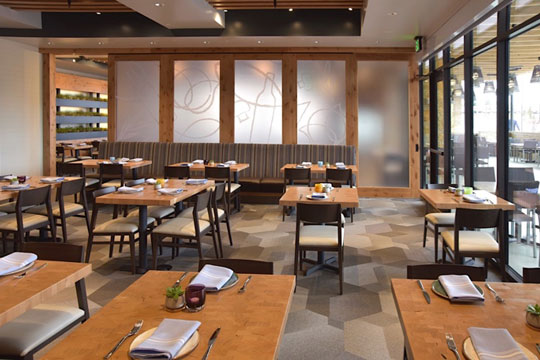Savor Authentic Oriental Food With a Pan-Asian Twist for a Cooking Adventure
Starting a culinary journey through genuine Eastern food, enhanced with a Pan-Asian twist, provides an one-of-a-kind possibility to explore the rich tapestry of tastes that specify the area's diverse culinary traditions. This experience invites you to enjoy the elegant equilibrium of preferences-- wonderful, salty, spicy, and sour-- balanced by aromatic natural herbs and seasonings. Visualize the cutting-edge blend of Thai curry and ramen or the unanticipated joy of sushi burritos. As you consider these luring meals, consider the cultural stories and historical influences that shape them, each bite supplying a tale waiting to be found.

Discovering Pan-Asian Flavors
In the world of global gastronomy, Pan-Asian food sticks out for its remarkable variety and the harmonious interplay of tastes from various Eastern cultures. This cooking approach commemorates the one-of-a-kind components and abundant practices discovered throughout the continent, creating a tapestry of tastes that is both satisfying and appealing. Trick to Pan-Asian cuisine is its capability to stabilize contrasting tastes-- pleasant, salty, spicy, and sour-- while highlighting the quality and high quality of each active ingredient.
From the umami-rich soy sauce of Japan to the fiery chili peppers of Thailand, Pan-Asian food uses an extensive combination of flavors. These components are often incorporated in creative ways, boosting meals with layers of intricacy. For example, making use of great smelling herbs such as lemongrass and cilantro, usual in Vietnamese and Thai cuisine, adds a refreshing brightness to meals, while the unification of coconut milk supplies a luscious, rich texture.
The emphasis on fresh produce and fragrant spices guarantees that each dish is not just a banquet for the palate but also for the senses. Pan-Asian food welcomes restaurants to begin on a cooking journey, checking out the large and varied landscapes of Asian gastronomy with every bite.
Fusion Recipes to Attempt
While Pan-Asian cuisine is commemorated for its conventional tastes, the contemporary cooking landscape is significantly accepting fusion recipes that mix these timeless elements with influences from various other regions. This ingenious method not just honors the rich heritage of Oriental cookeries however also introduces unique taste experiences that interest contemporary tastes buds.
A prime example of such a combination dish is the Korean-Mexican taco, where seasoned bulgogi beef is wrapped in a cozy tortilla, covered with kimchi and a hot gochujang-infused salsa. This combination weds the bold, mouthwatering flavors of Korea with the lively, fresh elements of Mexican food. Similarly, sushi burritos have obtained popularity, joining together the fragile artistry of Japanese sushi with the passionate, hand-held ease of a burrito, commonly featuring blend ingredients like tempura shrimp and avocado with a drizzle of wasabi mayo.
An additional significant meal is Thai curry ramen, which instills the creamy, aromatic seasonings of Thai curry right into the reassuring broth of conventional Japanese ramen, developing a harmonious blend that tantalizes the senses. These combination meals prolong past plain uniqueness; they stand for a cooking discussion in between societies, urging expedition and development in the globe of Pan-Asian food.
Crucial Ingredients and Spices
To absolutely value Pan-Asian food, one need to comprehend the necessary active ingredients and seasonings that develop its foundation. This varied his comment is here cooking design attracts from an abundant tapestry of Oriental traditions, using a harmonious mix of appearances and tastes.
Aromatic components are critical, with garlic, ginger, and lemongrass being common here are the findings across numerous Pan-Asian recipes. These active ingredients supply a fragrant base that boosts the complexity of tastes. Spices such as celebrity anise, cardamom, and cinnamon introduce warmth and character, resembling influences from areas like China and India.

Cooking Methods and Tips
Grasping the art of Pan-Asian food calls for familiarity with its distinctive cooking methods, each adding to the vivid tapestry of tastes this cooking practice is commemorated for. Central to these methods is the stir-fry, a rapid cooking technique that preserves the nutritional stability and brilliant colors of components. Using a frying pan, the stir-fry technique enables for also warm distribution, necessary for attaining the particular appearance and taste equilibrium of Pan-Asian meals.
One more essential technique is steaming, especially prevalent in Chinese cuisine. This mild approach keeps the all-natural flavors and nutrients of components, making it optimal for fish and shellfish and veggies. Dumplings, a precious staple, often take advantage of steaming, causing soft, delicious structures.
Grilling, also integral, presents great smoky depths to dishes such as Oriental bulgogi or Japanese yakitori (Instagrammable restaurants Islamabad). This strategy typically includes marinating active ingredients, permitting flavors to penetrate deeply prior to cooking over an open fire or warmer
Last but not least, grasping the art of stabilizing flavors-- wonderful, sour, salted, bitter, and umami-- is critical. Appropriately layering these aspects can elevate a meal from common to extraordinary, supplying a complicated and pleasing cooking experience that embodies the significance of Pan-Asian cuisine.
Eating Experiences Worldwide
Across the world, Pan-Asian cuisine offers an unrivaled eating experience, commemorated for its abundant tapestry of tastes and lively presentations. This cooking phenomenon has actually transcended cultural borders, catching the hearts and tastes of food lovers worldwide. In cosmopolitan cities fresh York, London, and Sydney, Pan-Asian dining establishments function as melting pots where cooking customs from Thailand, Japan, China, and beyond merge, supplying diners with an eclectic mix of recipes that highlight the area's diversity.
The global charm of Pan-Asian food hinges on its capability useful reference to provide both credibility and advancement. Chefs skillfully wed conventional active ingredients such as lemongrass, soy sauce, and miso with modern techniques, resulting in meals that are both refreshingly brand-new and familiar. This blend allows diners to embark on a cooking trip that respects heritage while embracing modernity.
Moreover, dining experiences are raised through attentively developed environments that reflect the values of Pan-Asian looks. From minimalist Japanese-inspired interiors to vivid Thai-themed rooms, each restaurant provides a special setting that enhances the cooking offerings. Therefore, clients are not just taking in a meal but partaking in a social experience, making Pan-Asian eating a genuinely worldwide phenomenon.
Verdict
The expedition of Pan-Asian cuisine offers a profound understanding of the elaborate interplay of flavors and cooking practices throughout Asia. By welcoming blend meals such as Thai curry ramen and sushi burritos, the culinary trip not just highlights the versatility of standard components however likewise showcases ingenious modern techniques. This gastronomic journey, enhanced by vital flavors and cooking techniques, gives a special opportunity to value the cultural variety and culinary artistry that define Pan-Asian food on an international scale.
Embarking on a cooking trip with genuine Asian food, enhanced with a Pan-Asian spin, offers a special opportunity to discover the abundant tapestry of flavors that specify the area's varied culinary customs.In the world of worldwide gastronomy, Pan-Asian food stands out for its amazing variety and the unified interplay of flavors from numerous Asian cultures. Trick to Pan-Asian cuisine is its ability to stabilize different flavors-- wonderful, salted, spicy, and sour-- while highlighting the quality and quality of each component.
